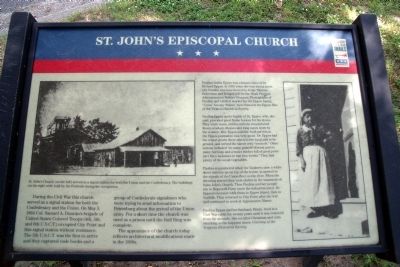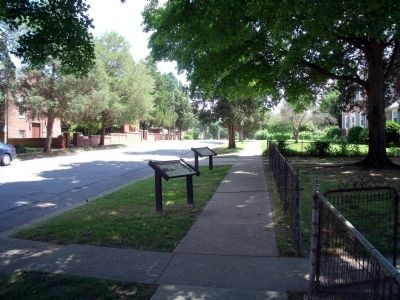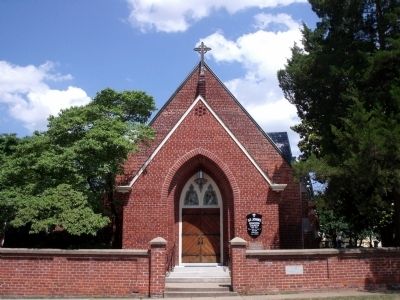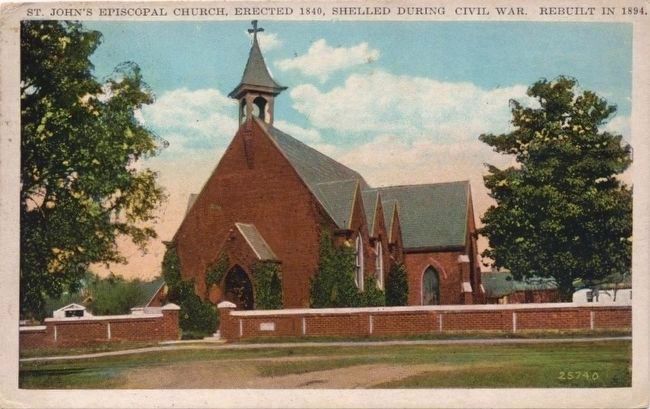Hopewell, Virginia — The American South (Mid-Atlantic)
St. Johnís Episcopal Church
During the Civil War this church served as a signal station for both the Confederacy and the Union. On May 5, 1864 Col. Samuel A. Duncanís brigade of United States Colored Troops (4th, 5th, and 6th U.S.C.T.) occupied City Point and the signal station without resistance. The 5th U.S.C.T. was the first to arrive and they captured code books and a group of Confederate signalmen who were trying to send information to Petersburg about the arrival of the Union army. For a short time the church was used as a prison until the Bull Ring was complete.
The appearance of the church today reflects architectural modifications made in the 1890s.
(sidebar)
Paulina Ruffin Eppes was a former slave of Dr. Richard Eppes. In 1939 when she was ninety years old, Paulina was interviewed by Judge Thomas Robertson and Roland Gill for the Work Projects Administration Writerís Program. Photographs of Paulina and a fellow worker for the Eppes family, ďUncleĒ George Wilson, were found in the Eppes files of the Virginia Historical Society.
Paulina Eppes spoke highly of Dr. Eppes, who, she said, provided good frame house for his slaves. They wore warm clothes and she remembered linsey-woolsey dresses and long capes worn by the women. Mrs. Eppes said the food served on the Eppes plantation was very good. Dr. Eppes had the wheat grown there taken to the local mill to be ground, and served the slaves with ďseconds.Ē Other rations included ďso many pounds of meat and so many herrings and a water bucket full of good porte [sic] Rico molasses to last two weeks.Ē They had plenty of the usual vegetables.
Paulina remembered when the Yankees came a white sheet was run up on top of the house, in answer to the signals of the Union fleet on the river. When the shooting started they took shelter in the basement of Saint Johnís Church. Then Paulina and her people ran to Hopewell Farm (now the industrial area). Dr. Eppesís overseer took them to Eppes Island, then to Norfolk. They returned to City Point after the war and continued to work at Appomattox Manor.
Paulina Eppes and her husband, Henry, lived in a Civil War cabin for twenty years until it was removed from the grounds. She recalled Christmas and corn shucking as the happiest times. Courtesy of the Virginia Historical Society.
Erected by Virginia Civil War Trails.
Topics and series. This historical marker is listed in these topic lists: African Americans • Churches & Religion • Communications • War, US Civil • Women. In addition, it is included in the Virginia Civil War Trails series list. A significant historical month for this entry is May 1864.
Location.
This marker has been replaced by another marker nearby. It was located near 37° 18.802′ N, 77° 16.62′ W. Marker was in Hopewell, Virginia. Marker was at the intersection of Cedar Lane and Maplewood Avenue, on the right when traveling south on Cedar Lane. Touch for map. Marker was in this post office area: Hopewell VA 23860, United States of America. Touch for directions.
Other nearby markers. At least 8 other markers are within walking distance of this location. A different marker also named St. John's Episcopal Church (here, next to this marker); The Bull Ring At City Point (a few steps from this marker); St. John's Episcopal Church Bell (within shouting distance of this marker); Dr. Peter Eppes House (about 500 feet away, measured in a direct line); Porter House (about 600 feet away); City Point, Virginia (about 700 feet away); a different marker also named City Point (about 700 feet away); Appomattox Manor (about 700 feet away). Touch for a list and map of all markers in Hopewell.
More about this marker. On the upper left is a photo with the caption, "St. Johnís Church (on the left) served as a signal station for both the Union and the Confederacy. The buildings on the right were built by the Federals during the occupation."
On the right is a photo of Paulina Eppes, a former slave on the Appomattox Plantation. Courtesy of the Virginia Historical Society.
Related marker. Click here for another marker that is related to this marker. New Marker At This Location also titled "St. John's Episcopal Church".
Also see . . . Petersburg National Battlefield - Biographies. Richard Eppes. (Submitted on June 8, 2009, by Bernard Fisher of Richmond, Virginia.)
Credits. This page was last revised on November 6, 2021. It was originally submitted on June 3, 2009, by Bernard Fisher of Richmond, Virginia. This page has been viewed 1,372 times since then and 37 times this year. Photos: 1. submitted on June 3, 2009, by Bernard Fisher of Richmond, Virginia. 2, 3. submitted on June 4, 2009, by Bernard Fisher of Richmond, Virginia. 4. submitted on November 13, 2015.



